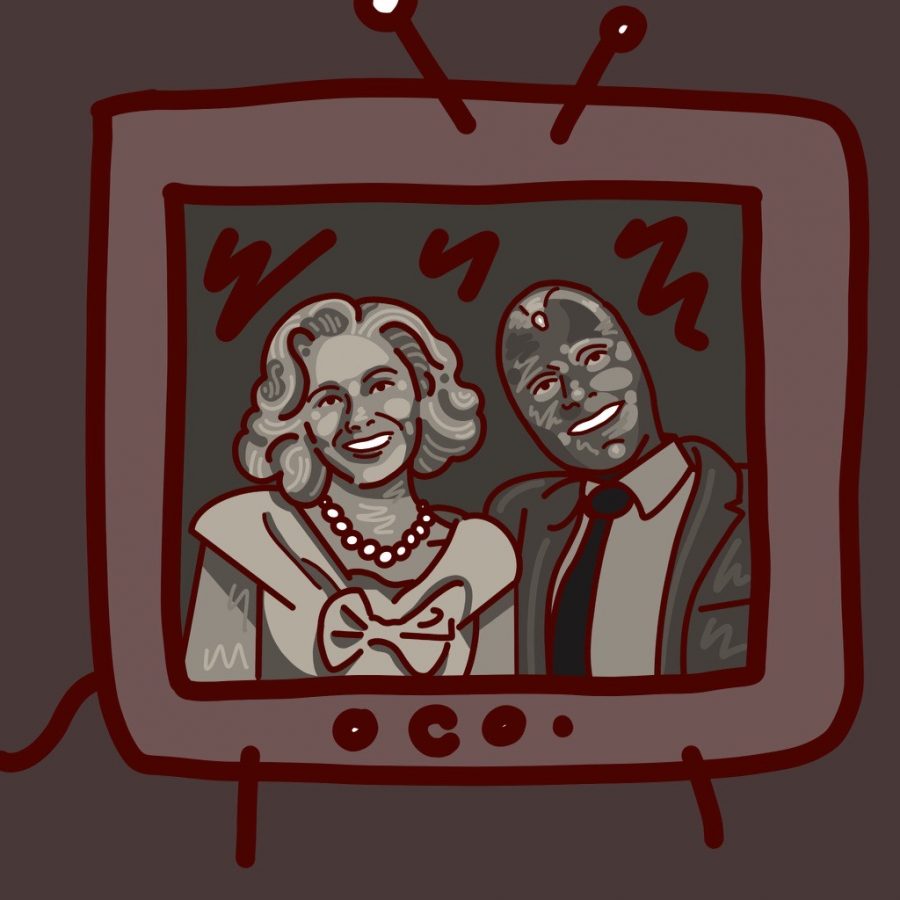“WandaVision” sets its eyes on a complex and fun future for Marvel
March 19, 2021
WandaVision, a nine episode miniseries kickstarting the Marvel Cinematic Universe’s Phase Four, aired on Disney+ on Jan. 15 and ran until March 5. It takes place not long after the events of Avengers: Endgame and, similarly to Spider-Man: Far From Home, it explores in greater detail the aftereffects of The Snap.
The show stars Elizabeth Olson and Paul Bettany, who reprise their respective roles from previous MCU movies as Wanda Maximoff and Vision. The story follows Wanda and Vision’s white picket fence American Dream-esque life in Westview, New Jersey, as they try to hide their true identities as a witch and a synthezoid from the other civilians.
Starting in the 1950s, the show moves through each decade leading up to the present, and with each new fashion trend, Wanda and Vision form new doubts and begin to question their surroundings and their reality, only knowing that the one thing they never come to doubt is their love.
As reported by Insider, WandaVision became the most popular series in the entire world since its debut and was the most in-demand series in the United States.The show has received praise from critics for its incredible production and cinematography. As for every new Marvel Studios project — with the exception of The Incredible Hulk,— the expectations for WandaVision were high.
Though the trailers didn’t give away much, and the show was certainly not easy to explain in a short blurb on the Marvel website, the anticipation to uncover its mysteries was boiling over before it even aired.
So, with expectations sky-high and this being Marvel’s first project in Phase Four, there were only two options for WandaVision: deliver or colossally disappoint.
As noted by many critics, the production of WandaVision truly exceeded any and all expectations.The show was filmed in a sitcom style, and as it carried its viewers through the decades, it shifted the cinematography, editing and writing styles to match those of each time period. Each episode was inspired by a multitude of different popular sitcoms, borrowing commonly used tropes from the respective decade.
The show’s writing perfectly balanced a sitcom’s infamously unrealistic writing style with the MCU’s comedy and hyperrealism.
Olson and Bettany finally got to explore Wanda and Vision without the constraints of the world toppling down on their shoulders, and in only two months’ time, viewers came to deeply resonate with and care about these characters who had been undermined previously.
The remarkable set and costume design created a historically authentic experience for the viewers by not leaving a single detail out of place, including elements like a live audience laugh and contemporary newspapers. Overall, the production of the show far surpassed anything that any Marvel fan could have dreamed of.
However, while the production did a marvelous job of knocking people off their feet, WandaVision still had quite a few setbacks that slapped their viewers back to their respective realities. One of Marvel’s biggest challenges has been notoriously pacing. The film juggernaut loves stretching time out as if it has an endless supply of it sitting in a box somewhere on set alongside plastic hammers and shields, forcing directors to pack in entire plots into the last thirty minutes of a movie.
Unfortunately, WandaVision was subject to this fate as well. The first three episodes carried nothing but small hints towards the out-of-sitcom world, episode four was fully set in the out-of- sitcom world and, moving from there, the episodes alternated scenes between inside and outside of the sitcom.
Instead of focusing on unveiling the mysteries that were set up in the first three episodes, the show only built on them and took on more roads that essentially led to nowhere. Most of the big reveals and resolutions were packed into the last episode, which ran for fifty minutes.
Not only was the pacing uncomfortable, but the ending itself was quite underwhelming with too many antagonists introduced and none of them getting a truly satisfying ending. Comparing these three different antagonists by the end of episode nine is nearly impossible, which makes the characters and their roles appear misplaced and awkward in the overall storyline.
WandaVision ended with a lot of plot holes left unaddressed. According to Marvel, this was due to the obstacles that the pandemic created. Travel restrictions made it impossible for some actors to get to set at times, meaning production of the show had to be either completely halted to a stop or overly sped up. With missing cast members or unfinished special effects, many scenes had to be cut.
This poses a question: taking into consideration the overall impact that the pandemic had on the MCU timeline, would it have been better to postpone the three miniseries that Marvel is releasing this year — WandaVision, The Falcon and the Winter Soldier and Loki?
Marvel endings are usually safe from excessive criticism, as no movie or series truly embodies the end. Most Marvel endings tend to be in the likes of transitional words, pointing the viewers in the direction of the next upcoming project.
Since WandaVision was the debut of Phase Four, it certainly included a lot of so-called transitional words in its ending, paving the way for Wanda’s next appearance in Marvel’s upcoming Dr. Strange in the Multiverse of Madness set to come out in March 2022. One of the show’s post-credit scenes might have also briefly set the viewers up for Captain Marvel 2, coming November 2022.
So, though WandaVision was a wild ride with a bumpy end, it is safe to say that when it comes to Marvel, what seems like an ending may just be an opportunity for a sequel.







